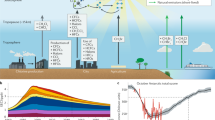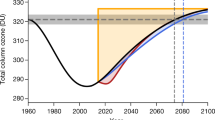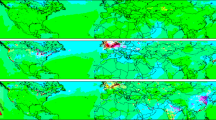Abstract
The burden of ozone-depleting chemicals in the lower atmosphere has been decreasing since 1994 as a result of the Montreal Protocol1,3. Here we show how individual chemicals have influenced this decline, in order to estimate how the burden could change in the near future. Our measurements of atmospheric concentrations of the persistent, anthropogenic chemicals that account for most ozone-depleting halogens in today's stratosphere show that the decline stems predominantly from the decrease in the atmospheric load of trichloroethane (CH3CCl3), a previously common cleaning solvent. The influence of this chemical on the decline has now peaked, however, and will become much smaller over the next five to ten years. As this influence lessens, a decrease in theburden of ozone-depleting halogen will be sustained only if emissions of other halocarbons fall. Although emissions of most gases regulated by the Montreal Protocol have decreased substantially over the past ten years (refs 4), emissions of the potent ozone-depleting gas CBrClF2 (halon-1211) have remained fairly constant during this period12,29, despite stringent limits on production in developed countries since 1994. The consequent atmospheric accumulation of this halon is retarding the decline of ozone-depleting halogens in the atmosphere more than any other persistent gas.
This is a preview of subscription content, access via your institution
Access options
Subscribe to this journal
Receive 51 print issues and online access
$199.00 per year
only $3.90 per issue
Buy this article
- Purchase on Springer Link
- Instant access to full article PDF
Prices may be subject to local taxes which are calculated during checkout



Similar content being viewed by others
References
Montzka, S. A. et al. Decline in the tropospheric abundance of halogen from halocarbons: Implications for stratospheric ozone depletion. Science 272, 1318–1322 (1996).
! Cunnold, D. M. et al. GAGE/AGAGE measurements indicating reductions in global emissions of CCl3F and CCl2F2in 1992–1994. J. Geophys. Res. 102, 1259–1269 (1997).
Report of the Ninth Meeting of the Parties to the Montreal Protocol on Substances that Deplete the Ozone Layer (Montreal) (United Nations Environmental Programme, New York, 1997).
Scientific Assessment of Ozone Depletion: 1994 (Rep. No. 37, World Meteorological Organization, Geneva, 1995).
Elkins, J. W. et al. Decrease in the growth rates of atmospheric chlorofluorocarbons 11 and 12. Nature 364, 780–783 (1993).
Production, Sales and Atmospheric Release of Fluorocarbons Through 1995 (AFEAS, Washington DC, 1997).
Fisher, D. A. et al. in Report on Concentrations, Lifetimes, and Trends of CFCs, Halons, and Related SpeciesCh. 2 (NASA ref. publ. 1339, Washington DC, 1994).
Midgley, P. M. & McCulloch, A. The production and global distribution of emissions to the atmosphere of 1,1,1-trichloroethane (methyl chloroform). Atmos. Environ. 29, 1601–1608 (1995).
Fraser, P. et al. Lifetime and emission estimates of 1,1,2-trichlorotrifluorethane (CFC-113) from daily global background observations June 1982–June 1994. J. Geophys. Res. 101, 12585–12599 (1996).
Simmonds, P. G. et al. Global trends and emission estimates of CCl4from in situ background observations from July 1978 to June 1996. J. Geophys. Res. 103, 16017–16028 (1998).
Prinn, R. G. et al. Atmospheric trends and lifetime of CH3CCl3and global OH concentrations. Science 269, 187–192 (1995).
Butler, J. H. et al. Growth and distribution of halons in the atmosphere. J. Geophys. Res. 103, 1503–1511 (1998).
Prather, M. J. & Watson, R. T. Stratospheric ozone depletion and future levels of atmospheric chlorine and bromine. Nature 344, 729–734 (1990).
Daniel, J. S., Solomon, S. & Albritton, D. L. On the evaluation of halocarbon radiative forcing and global warming potentials. J. Geophys. Res. 100, 1271–1285 (1995).
Jackman, C. H. et al. Past, present, and future modeled ozone trends with comparisons to observed trends. J. Geophys. Res. 101, 28753–28767 (1996).
Portmann, R. W. et al. Role of aerosol variations in anthropogenic ozone depletion in the polar regions. J. Geophys. Res. 101, 22991–23006 (1996).
Solomon, S. et al. The role of aerosol variations in anthropogenic ozone depletion at northern midlatitudes. J. Geophys. Res. 101, 6713–6727 (1996).
Shindell, D. T., Rind, D. & Lonergan, P. Increased polar stratospheric ozone loss and delayed eventual recovery owing to increasing greenhouse-gas concentrations. Nature 392, 589–592 (1998).
McCulloch, A. Global production and emissions of bromochlorodifluoromethane and bromotrifluoromethane (halons 1211 and 1301). Atmos. Environ. A 26, 1325–1329 (1992).
UNEP Technology and Economic Assessment Panel April 1998 Report (United Nations Environment Programme, Nairobi, Kenya, 1998); also available at 〈http://www.teap.org/html/teap_reports.html〉.
Prather, M. J. et al. in Climate Change 1995, the Science of Climate Change (eds Houghton, J. T. et al.) Ch. 33 (Cambridge Univ. Press, 1996).
Report of the Halon Fire Extinguishing Agents Technical Options Committee (United Nations Environment Programme, Nairobi, Kenya, 1994).
Volk, C. M. et al. Evaluation of source gas lifetimes from stratospheric observations. J. Geophys. Res. 102, 25543–25564 (1997).
Burkholder, J. B. et al. Atmospheric fate of CF3Br, CF2Br2, CF2ClBr, and CF2BrCF2Br. J. Geophys. Res. 96, 5025–5043 (1991).
Butler, J. H. et al. Adecrease in the growth rates of atmospheric halon concentrations. Nature 359, 403–405 (1992).
Montzka, S. A. et al. Global tropospheric distribution and calibration scale of HCFC-22. Geophys. Res. Lett. 20, 703–706 (1993).
Montzka, S. A. et al. Early trends in the global tropospheric abundance of hydrochlorofluorocarbon-141b and -142b. Geophys. Res. Lett. 21, 2483–2486 (1994).
Trenberth, K. E. & Guillemot, C. J. The total mass of the atmosphere. J. Geophys. Res. 99, 23079–23088 (1994).
Fraser, P. J. et al. Southern hemispheric halon trends (1978–1998) and global halon emissions. J. Geophys. Res.(in the press).
Acknowledgements
We thank all personnel involved in collecting flask samples at the NOAA/CMDL Observatories and at cooperative sampling sites. S.A.M. appreciates discussions and suggestions from S.Solomon and P. Midgley, and we appreciate the past technical assistance of R. C. Myers and T. H. Swanson. This work was supported in part by NOAA's Radiatively Important Trace Species research and by the Atmospheric Chemistry project of the NOAA Climate and Global Change Program.
Author information
Authors and Affiliations
Corresponding author
Rights and permissions
About this article
Cite this article
Montzka, S., Butler, J., Elkins, J. et al. Present and future trends in the atmospheric burden of ozone-depleting halogens. Nature 398, 690–694 (1999). https://doi.org/10.1038/19499
Received:
Accepted:
Issue Date:
DOI: https://doi.org/10.1038/19499
This article is cited by
-
Thermal Conductivity of Low-Density Polyethylene Foams Part II: Deep Investigation using Response Surface Methodology
Journal of Thermal Science (2020)
-
Influence of low ozone episodes on erythemal UV-B radiation in Austria
Theoretical and Applied Climatology (2018)
-
Detecting recovery of the stratospheric ozone layer
Nature (2017)
-
Emission quantification of refrigerant CFCs, HCFCs and HFCs in megacity Lahore (Pakistan) and contributed ODPs and GWPs
Journal of Earth System Science (2016)
-
Estimating emissions of HCFC-22 and CFC-11 in China by atmospheric observations and inverse modeling
Science China Chemistry (2012)
Comments
By submitting a comment you agree to abide by our Terms and Community Guidelines. If you find something abusive or that does not comply with our terms or guidelines please flag it as inappropriate.



